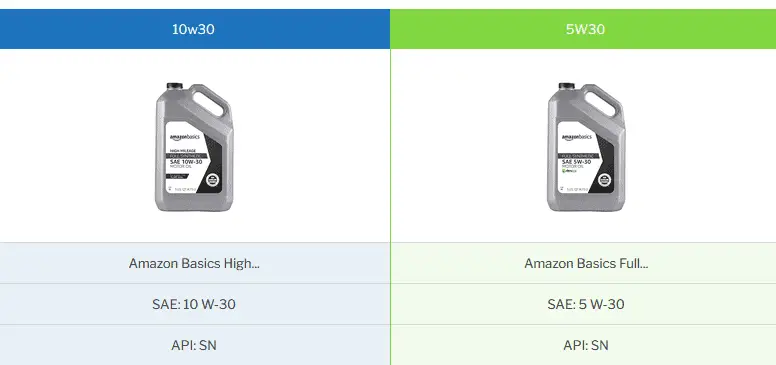You have a lot to consider when choosing and purchasing the right motor oil for your vehicle. So many different oils are available that it can be overwhelming to make sense.
Recently, we tried to answer whether we can mix oil brands. (our article)
5w30 Oil is one of the most common types of motor oil and is also among the most versatile. It can be used in a wide range of vehicles and is sometimes recommended by manufacturers. We made an interesting article about the Difference between 5w20 and 5w30 Oil.
So when should you use 5w30 Oil? Read on to learn more about this popular type of motor oil and how it might benefit you.
When Should I Use 5w30 Oil?
5w30 Oil represents winter viscosity grade motor oil. You should use 5w30 Oil if your location temperature range is as low as -30ºC (-22 F) and as high as 35ºC (95 F) for petrol vehicles or a light-duty diesel engine.
Check your owner’s manual for specific recommendations about what type of Oil to use when changing your car’s Oil. Generally, 5W30 Oil is suggested for most vehicles in climates that do not dip below freezing at night.
5W30 is a multi-grade oil that can be used in winter and summer. 5W30 Oil is fragile in cooler temperatures and will flow readily through the engine, allowing it to start more easily on cold mornings. In warmer weather, 5W30 Oil’s viscosity is thicker than the viscosity of 5W40 or 10W40 oils, allowing more excellent lubrication of your vehicle’s engine parts in hotter months.
5W30 is ideal for cars in areas where the temperature does not drop below freezing but can get quite hot during the day. Since this oil grade is thinner than others, it can flow more easily through engines when boiling.
If the temperature in your area tends to be colder than usual, you may want to consider using 10W30 instead. This Oil flows more easily in freezing temperatures and can make starting your car easier when it’s chilly outside.
Can I Use 10w30 Instead of 5w30?
Yes, you can use 10W30 instead of 5W30. You can usually use these two types of Oil interchangeably since they are both winter multi-viscosity oils. However, 10W30 is thicker than 5W30, so you should use 5W30 if winter is really cold because of the different viscosities.

The only Difference between these two oils is their thickness when cold and at operating temperatures. The “5” in 5w30 means it is thicker at lower temperatures than the “10” in 10w30. This could lead to some oil consumption issues if you live somewhere that gets very cold in the winter, but it should not be a problem if your vehicle does not consume much Oil.
If your vehicle consumes a lot of Oil, we recommend using 5w20 or 5w30 instead of 10w30 because it will flow through the engine better when cold outside.
Remember that if you use 10w30 instead of 5w30, you should use the same oil brand each time because some brands have differences that affect how well they work with your vehicle.
Can You Mix 10w30 and 5w30?
Yes, you can technically mix 10w30 and 5w30 when you do not have the option because they are both multi-grade winter oils. However, it’s not recommended to mix oils with different viscosity.
On the one hand, mixing different oil weights may seem like a practical solution in an emergency. For instance, maybe you’re on the road and have run out of 10w30. Would adding some 5w30 to get your engine running instead of going without any oil would be better?
While that may seem like a good idea, we advise against it. If your engine is designed to run on 10w30, adding 5w30 could cause the Oil to become too thin for the engine’s components to be adequately lubricated. This is especially true if you’re adding a lot of 5w30 into what was initially mostly 10w30.
A better option is to see if you can find more 10w30 instead of mixing the two types of Oil and potentially damaging your engine later.
On the other hand, this might depend on several factors, including your car type. If you have a high-performance engine, you must use the correct type of Oil to maintain your vehicle. Using 10w30 instead of 5w30 could damage or destroy your engine.
There are some circumstances where it might be acceptable to use 10w30 instead of 5w30. The first is when you don’t have any other options. If you’re stranded in the middle of nowhere and must keep your car running for safety reasons, it’s probably better to use 10w30 than nothing.
Another situation where it might be OK to use 10w30 is if it’s an emergency and your engine is already damaged. If your engine has already been destroyed by using the wrong type of Oil, temporarily using Oil0w30 might prevent you from having to replace the entire engine immediately.
However, if there are no extenuating circumstances and your engine has not been damaged, do NOT use 10w30. Even if you think it’s just a minor issue, using the wrong type of Oil causes significant problems over time, so stick to what’s recommended for your vehicle.
What Difference Between 5w30 and 10w30?
A 5w30 oil is thinner when cold than a 10w30 motor oil. A 10w30 oil has a higher viscosity and will flow less at lower temperatures than a 5w30 motor oil.
If you’re trying to determine your car’s best oil car, you’ve probably run into 5w30 and 10w30. These two oils are very similar but designed for different types of vehicles and conditions.
To understand the Difference between these two kinds of engine oil, it’s essential to know what the numbers on the label mean:
The first number denotes the Oil’s Oil’ssity grade at low temperatures, and the second digit indicates the viscosity grade at higher temperatures.
Here’s an example: A 10w30 oil has a viscosity of 10 when it’s cold (like when you start your car) and 30 when it’s hot (like when driving around on a hot day). Viscosity is just a complicated way of talking about how thick or thin a liquid is—and in this case, it refers to how easily the Oil will flow through your car engine.
So, what does all this mean? This means that 10w30 will flow slightly faster than 5w30 when both oils are cold. However, once the Oil is up, it’ll have the same viscosity (or thickness) because the second number stays the same.
What Will Happen if I Put 10w30 Instead of 5w30?
If you put 10w30 Oil in an oil load of 5w30, your engine will experience more wear. However, it may not necessarily be damaged beyond repair.
First, let’s make sure you know what it all means. The numbers 5 and 10 refer to the viscosity of the Oil. TOil is a fancy word that means how thick or thin the Oil is. It’s cold—at room temperature. When motor oil is cold, it tends to be more viscous (thicker) than when it gets hot. So 5w30 is thinner when it’s cold and thicker when it’s hot than 10w30 is.
The “W” stands for winter, which affects how well the Oil flows in cold temperatures (like during winters in New York).
What happens if you put 10w30 instead of 5w30? Your car will probably still run fine. Since it’s a bit thicker than what your car needs, you may notice that your engine takes a little longer to get started on cold mornings (since thicker oils take longer to circulate). You may also experience less fuel efficiency, but once the engine warms up and thins out the Oil, there shouldn’t be any problem.
However, it’s not recommended to put 10w30 on a 5w30 compatible vehicle again.
Is 5w30 or 10w30 Better for Summer?
Technically speaking, 10w30 is better for summer. However, changing your 5w30 Oil with 10w30 if your vehicle is better suited to run with 5w30 Oil is unnecessary.
Both 5W30 and 10W30 are oil viscosity grades. They have the same viscosity at average operating temperatures but differ in their low-temperature viscosity. What does this mean for your car? Your 5W30 or 10W30 will depend on your owner’s manual and the climate where you operate your vehicle.
5W30 is the most common grade of motor oil in the summer, whether you live in Alaska or Miami Beach. It is a multi-grade oil that can be used year-round.
10W30 has a slightly higher viscosity than 5W30, meaning it can be used in colder temperatures than 5W30. However, its high-temperature viscosity is lower than that of 5W30. This means 10W30 performs better at higher temperatures than 5W30 does.
Ultimately, you should follow the recommendations in your vehicle’s owner’s manual (they can vary by manufacturer). If you’re still confused, consult a mechanic to help you make the chosen climate.
Conclusion
Ultimately, if you can’t find the answer to your oil change questions in this article (or elsewhere online), a Guldur local auto parts store or mechanic asks them directly. You might even consider making an appointment for your first oil change so that you won’t have to worry about being unable to fit it into your schedule later on down the road.
